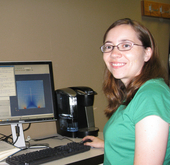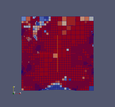Highlight
Finite Element Modeling of Fracture Incorporating Crack Surface Interfacial Effects
Achievement/Results
Fracture is one of the most important issues in the design of materials for aircraft and other structures. However, our understanding of the fundamental mechanisms controlling such behavior remains incomplete, leading to overdesign and sometimes to catastrophic failure. Classical brittle fracture modeling is set in the context of the linearized theory of elasticity and a crack is modeled as a surface (in 3-dimensions) or a line (in 2-dimensions) across which the displacement can exhibit a jump discontinuity when the body is placed under an external thermal or mechanical load. Moreover, classically a crack surface is viewed as a free-surface on which tractions can be freely imposed as a boundary condition. This classical theory of fracture contains a logical inconsistency whereby solutions to crack boundary value problems predict infinite stresses and strains at a crack-tip while the governing equations are derived under the assumption that stresses and strains remain infinitesimally small. While often ignored in practice, this logical inconsistency gives rise to unrealistic predictions of crack-tip stresses and strains.
Lauren Ferguson, a graduate student in Mathematics at Texas A&M University, is a member of the “New Mathematical Tools for Next Generation Materials” interdisciplinary team, with support from the NSF-IGERT (Integrative Graduate Education and Research Traineeship) program. Her traineeship included a new, strongly interdisciplinary curriculum including Materials Science as well as Applied Mathematics coursework, and research experiences with faculty from this team covering several departments. In her Ph.D. research she worked with J. R. Walton (Department of Mathematics) to develop an alternative fracture modeling paradigm in which crack surfaces are viewed as “dividing surfaces” endowed with “excess” physical properties (mass, internal energy, stress, entropy, temperature).
This work is a part of a larger effort with several collaborators including John Slattery (Aerospace Engineering) to develop mathematical tools to address real-world materials problems. The theoretical basis for this model approach was introduced and analyzed {Sendova and Walton, A new approach to the modeling and analysis of fracture through extension of continuum mechanics to the nanoscale, Math. Mech. Solids, 15(3), 2010, 368-413} by a homogenization procedure whereby the excess properties on material interfaces (such as fracture surfaces) arise as an asymptotic limit of an infinitesimally thin interfacial region adjoining distinct material phases. For a fracture surface, the distinct, adjoined phases are the intact bulk solid phase and the vacuum (or gas or fluid) phase occupying the opened crack. In this setting, crack surfaces are no longer free surfaces on which boundary conditions can be freely imposed. Rather, the appropriate boundary conditions are prescribed through the jump momentum balance. One must then impose a constitutive model for stress-deformation behavior within the interface. Lauren Ferguson’s contribution to this long-term project has been to develop a finite element analysis of the new fracture model.
It is a very challenging project requiring a significant departure from classical finite element fracture modeling. Her work breaks significant new ground and is providing a computational tool to be applied to the important engineering problem of predicting when a cracked structure (such as a critical structural component in an airframe) is safe to continue in service or when it must be repaired or replaced. Algorithms coming from her work are soon to be tested and implemented by engineering groups working in both the Air Force and Army research laboratories.
Address Goals
In the work by Ferguson, two different constitutive models for surface tension have been studied: constant surface tension and curvature dependent surface tension. Her finite element studies confirm the theoretical predictions that the constant surface tension model produces crack-tip profiles with finite, nonzero opening angle and singular crack-tip stresses, whereas the curvature dependent surface tension model predicts a smooth, cusp-shaped crack-tip opening profile and corresponding bounded crack-tip stresses. The graph illustrates such a multi-scale analysis, where the colors correspond to different stress magnitudes, and the developing crack is surrounded by the blue high-stress area at the bottom.
Ferguson has given two talks in 2010 on this work, one a seminar at New Mexico State University and the other an invited talk at the SIAM Conference on Mathematical Aspects of Material Science in Philadelphia. This project could not have been accomplished without her highly interdisciplinary training through the IGERT program since it required her to be knowledgeable about modeling materials at the nano-scale (physics courses), macro-scale (mechanics courses), model analysis (math courses), and numerical analysis and scientific computing (math courses). Through her research she has helped to advance our fundamental understanding of materials properties, and at the same time made a significant contribution to a problem of great importance to our nation’s industry and defense. Furthermore, as an inaugural member of the IGERT-funded traineeship program at Texas A&M, Lauren’s experiences helped to shape this program and its curriculum, and as a result a new Interdisciplinary Mathematics curriculum is now in place incorporating some of the successes established through the IGERT program.







